Metabolism of Malus halliana Roots Provides Insights into Iron Deficiency Tolerance Mechanisms
Abstract
1. Introduction
2. Material and Methods
2.1. Plant Materials
2.2. Determination of Root Physiological Parameters
2.3. GC/MS Analysis
2.4. Data Preprocessing and Statistical Analysis
2.5. Selection of Differential Metabolites
2.6. Statistical Analysis
3. Results
3.1. Selecting the Time Point for Metabonomics Analysis in Roots of M. halliana Seedlings
3.2. Metabolic Trajectory of M. halliana Roots under Fe Deficiency Stress
3.3. Comparative Analysis of the Metabolites of M. halliana Root System under Fe Deficiency
3.4. Pathway Mapping and Metabolite-to-Metabolite Network Visualization
4. Discussion
4.1. Root System Changes of M. halliana Seedlings in Response to Fe Deficiency
4.2. Energy Homeostasis of M. halliana under Fe Deficiency Stress through Carbohydrate Dependent Metabolism
4.3. Amino Acid Metabolism, TCA Cycle, and the Response of Secondary Metabolites to Fe Deficiency Stress
5. Conclusions
Supplementary Materials
Author Contributions
Funding
Data Availability Statement
Acknowledgments
Conflicts of Interest
References
- Zhao, Y.; Liu, S.; Li, F.; Sun, M.; Liang, Z.; Sun, Z.; Yu, F.; Li, H. The low ferric chelate reductase activity and high apoplastic pH in leaves cause iron deficiency chlorosis in ‘Huangguan’pears grafted onto quince A grown in calcareous soil. Sci. Hortic. 2023, 310, 111754. [Google Scholar] [CrossRef]
- Kawahara, Y.; Kitamura, Y. Changes in cell size and number and in rhizodermal development contribute to root tip swelling of Hyoscyamus albus roots subjected to iron deficiency. Plant Physiol. Biochem. 2015, 89, 107–111. [Google Scholar] [CrossRef] [PubMed]
- Aras, S.; Arıkan, Ş.; İpek, M.; Eşitken, A.; Pırlak, L.; Dönmez, M.F.; Turan, M. Plant growth promoting rhizobacteria enhanced leaf organic acids, FC-R activity and Fe nutrition of apple under lime soil conditions. Acta Physiol. Plant. 2018, 40, 120. [Google Scholar] [CrossRef]
- López-Millán, A.F.; Morales, F.; Gogorcena, Y.; Abadía, A.; Abadía, J. Metabolic responses in iron deficient tomato plants. J. Plant Physiol. 2009, 166, 375–384. [Google Scholar] [CrossRef]
- Smeekens, S. Sugar-induced signal transduction in plants. Annu. Rev. Plant Biol. 2000, 51, 49–81. [Google Scholar] [CrossRef]
- Locato, V.; Cimini, S.; De Gara, L. Glutathione as a key player in plant abiotic stress responses and tolerance. In Glutathione in Plant Growth, Development, and Stress Tolerance; Springer: Cham, Switzerland, 2017; pp. 127–145. [Google Scholar]
- Cheng, G.; Karunakaran, R.; East, A.K.; Munoz-Azcarate, O.; Poole, P.S. Glutathione affects the transport activity of Rhizobium leguminosarum 3841 and is essential for efficient nodulation. FEMS Microbiol. Lett. 2017, 364, fnx045. [Google Scholar] [CrossRef]
- Geu-Flores, F.; Møldrup, M.E.; Böttcher, C.; Olsen, C.E.; Scheel, D.; Halkier, B.A. Cytosolic γ-glutamyl peptidases process glutathione conjugates in the biosynthesis of glucosinolates and camalexin in Arabidopsis. Plant Cell 2011, 23, 2456–2469. [Google Scholar] [CrossRef]
- Wei, J.C.; You, G.Y.; Zheng, S.J. The iron deficiency-induced phenolics secretion plays multiple important roles in plant iron acquisition underground. Plant Signal. Behav. 2008, 3, 60–61. [Google Scholar]
- Zhang, X.Y.; Jia, X.M.; Zhang, R.; Zhu, Z.L.; Liu, B.; Gao, L.Y.; Wang, Y.X. Metabolic analysis in Malus halliana leaves in response to iron deficiency. Sci. Hortic. 2019, 258, 108792. [Google Scholar] [CrossRef]
- Mori, S. Iron acquisition by plants. Curr. Opin. Plant Biol. 1999, 2, 250–253. [Google Scholar] [CrossRef]
- Ren, H.L.; Liu, B. The young rootstock of Malus halliana overwintered cultivation and management with orchard saplings. Gansu Agric. Sci. Technol. 1994, 4, 21–22. [Google Scholar]
- Wang, K.; Zhang, L.; Gao, M. Influence of salt stress on growth and antioxidant responses of two Malus species at callus and plantlet stages. Pak. J. Bot. 2013, 45, 375–381. [Google Scholar]
- Wang, Y.X.; Hu, Y.; Zhu, Y.F.; Baloch, A.W.; Jia, X.M.; Guo, A.X. Transcriptional and physiological analyses of short-term iron deficiency response in apple seedlings provide insight into the regulation involved in photosynthesis. BMC Genom. 2018, 19, 461–472. [Google Scholar] [CrossRef] [PubMed]
- Jia, X.M.; Zhu, Y.F.; Zhang, R.; Zhu, Z.L.; Zhao, T.; Cheng, L.; Gao, L.Y.; Liu, B.; Zhang, X.Y.; Wang, Y.X. Ionomic and metabolomic analyses reveal the resistance response mechanism to saline-alkali stress in Malus halliana seedlings. Plant Physiol. Biochem. 2020, 147, 77–90. [Google Scholar] [CrossRef]
- Hu, Y.; Zhu, Y.F.; Guo, A.X.; Jia, X.M.; Cheng, L.; Zhao, T.; Wang, Y.X. Transcriptome analysis in Malus halliana roots in response to iron deficiency reveals insight into sugar regulation. Mol. Genet. Genom. 2018, 293, 1523–1534. [Google Scholar] [CrossRef]
- Guo, A.; Hu, Y.; Shi, M.; Wang, H.; Wang, Y. Effects of iron deficiency and exogenous sucrose on the intermediates of chlorophyll biosynthesis in Malus halliana. PLoS ONE 2020, 15, e0232694. [Google Scholar] [CrossRef]
- Zhang, Z.X.; Zhang, R.; Wang, S.C.; Zhang, D.; Zhao, T.; Liu, B.; Wang, Y.X.; Wu, Y.X. Identification of Malus halliana R2R3-MYB gene family under iron deficiency stress and functional characteristics of MhR2R3-MYB4 in Arabidopsis thaliana. Plant Biol. 2022, 24, 344–355. [Google Scholar] [CrossRef]
- Hoagland, D.R. The water-culture method for growing plants without soil. In California Agricultural Experiment Station Circular; University of California, Berkeley: Berkeley, CA, USA, 1950; Volume 347. [Google Scholar]
- Grusak, M.A. Whole-root iron (III)-reductase activity throughout the life cycle of iron-grown Pisum sativum L. (Fabaceae): Relevance to the iron nutrition of developing seeds. Planta 1995, 197, 111–117. [Google Scholar] [CrossRef]
- Lei, G.J.; Zhu, X.F.; Wang, Z.W.; Dong, F.; Dong, N.Y.; Zheng, S.J. Abscisic acid alleviates iron deficiency by promoting root iron reutilization and transport from root to shoot in A rabidopsis. Plant Cell Environ. 2014, 37, 852–863. [Google Scholar] [CrossRef]
- Liu, W. Functional Research of Ethylene Response Factor ERF4/ERF72 Involved in Iron Deficiency Response of Apple Rootstocks; China Agricultural University: Beijing, China, 2017. [Google Scholar]
- Wang, X.K.; Zhang, W.H.; Hao, Z.B.; Li, X.R.; Zhang, Y.Q.; Wang, S.M. Principles and Techniques of Plant Physiological Biochemical Experiment; Higher Education Press: Beijing, China, 2006; pp. 118–119. [Google Scholar]
- Mao, F.C.; Zhang, F.Y.; Zhao, X.G.; Zhang, K.L. Relativity of active iron contents and chlorosis in the kiwi leaf. Acta Agric. Boreali-Occident. Sin. 2002, 11, 54–56. [Google Scholar]
- Bao, S.D. Soil Agricultural Chemistry Analysis; China Agricultural Press: Beijing, China, 2008; Volume 10–18, pp. 27–28. [Google Scholar]
- Schmidt, W.; Tittel, J.; Schikora, A. Role of hormones in the induction of iron deficiency responses in Arabidopsis roots. Plant Physiol. 2000, 122, 1109–1118. [Google Scholar] [CrossRef]
- Hindt, M.N.; Guerinot, M.L. Getting sense for signals: Regulation ofthe plantiron deficiency response. Biochim. Biophys. Acta 2012, 1823, 1521–1530. [Google Scholar] [CrossRef]
- Hong, J.; Wang, H.; Qiu, Z. Effect of iron deficiency on the ultrastructure in root and leaf cell of maize. J. Chin. Electron Microsc. Soc. 1999, 18, 590–595. [Google Scholar]
- Fan, Q.Q.; Sui, X.X.; Huang, C.Y.; Cui, D.Z.; Li, Y.B.; Chu, Q.S. Effects of iron deficiency stress on seedling related traits of wheat. Shandong Agric. Sci. 2018, 321, 33–38. [Google Scholar]
- Römheld, V.; Marschner, H. Iron Deficiency Stress Induced Morphological and Physiological Changes in Root Tips of Sunflower. Physiol. Plant. 1981, 53, 354–360. [Google Scholar] [CrossRef]
- Becker, R.; Manteuffel, F.R. Subcellular Localization and Characterization of Excessive Iron in the Nicotianamine-Less Tomato Mutant chloronerva. Plant Physiol. 1995, 108, 269–275. [Google Scholar] [CrossRef]
- Zha, Q.; Wang, Y.; Zhang, X.Z.; Han, Z.H. Both immanently high active iron contents and increased root ferrous uptake in response to low iron stress contribute to the iron deficiency tolerance in Malus xiaojinensis. Plant Sci. 2014, 214, 47–56. [Google Scholar] [CrossRef] [PubMed]
- Jin, C.W.; Chen, W.W.; Meng, Z.B.; Zheng, S.J. Iron deficiency-induced increase of root branching contributes to the enhanced root ferric chelate reductase activity. J. Integr. Plant Biol. 2008, 50, 1557–1562. [Google Scholar] [CrossRef] [PubMed]
- McCaskill, A.; Turgeon, R. Phloem loading in Verbascum phoeniceum L. depends on the synthesis of raffinose-family oligosaccharides. Proc. Natl. Acad. Sci. USA 2007, 104, 19619–19624. [Google Scholar] [CrossRef]
- Dasgupta, K.; Khadilkar, A.S.; Sulpice, R.; Pant, B.; Scheible, W.R.; Fisahn, J.; Stitt, M.; Ayre, B.G. Expression of sucrose transporter cDNAs specifically in companion cells enhances phloem loading and long-distance transport of sucrose but leads to an inhibition of growth and the perception of a phosphate limitation. Plant Physiol. 2014, 165, 715–731. [Google Scholar] [CrossRef]
- Lin, X.Y.; Ye, Y.Q.; Fan, S.K.; Jin, C.W.; Zheng, S.J. Increased sucrose accumulation regulates iron-deficiency responses by promoting auxin signaling in Arabidopsis plants. Plant Physiol. 2016, 170, 907–920. [Google Scholar] [CrossRef]
- Espen, L.; Dell’Orto, M.; Zocchi, N.G. Metabolic responses in cucumber (Cucumis sativus L.) roots under Fe-deficiency: a31P-nuclear magnetic resonance in-vivo study. Planta 2000, 210, 985–992. [Google Scholar] [CrossRef]
- Barpeled, M.; O’Neill, M.A. Plant nucleotide sugar formation, interconversion, and salvage by sugar recycling. Annu. Rev. Plant Biol. 2011, 62, 127–155. [Google Scholar] [CrossRef]
- Zocchi, G.; De Nisi, P.; Dell’Orto, M.; Espen, L.; Gallina, P.M. Iron deficiency differently affects metabolic responses in soybean roots. J. Exp. Bot. 2007, 58, 993–1000. [Google Scholar] [CrossRef] [PubMed]
- Wang, L.; Fu, J.; Li, M.; Fragner, L.; Weckwerth, W.; Yang, P. Metabolomic and proteomic profiles reveal the dynamics of primary metabolism during seed development of lotus (Nelumbo nucifera). Front. Plant Sci. 2016, 7, 750. [Google Scholar] [CrossRef]
- Walch-Liu, P.; Forde, B.G. Nitrate signalling mediated by the NRT1 1 nitrate transporter antagonises l-glutamate-induced changes in root architecture. Plant J. 2008, 54, 820–828. [Google Scholar] [CrossRef]
- Rizhsky, L.; Liang, H.J.; Shuman, J.; Shulaev, V.; Davletova, S.; Mittler, R. When defense pathways collide: The response of Arabidopsis to a combination of drought and heat stress. Plant Physiol. 2004, 134, 1683–1696. [Google Scholar] [CrossRef]
- Kisaka, H.; Kida, T. Transgenic tomato plant carrying a gene for NADP-dependent glutamate dehydrogenase (gdhA) from Aspergillus nidulans. Plant Sci. 2003, 164, 35–42. [Google Scholar] [CrossRef]
- Glevarec, G.; Bouton, S.; Jaspard, E.; Riou, M.T.; Cliquet, J.B.; Suzuki, A.; Limami, A.M. Respective roles of the glutamine synthetase/glutamate synthase cycle and glutamate dehydrogenase in ammonium and amino acid metabolism during germination and post-germinative growth in the model legume Medicago truncatula. Planta 2004, 219, 286–297. [Google Scholar] [CrossRef]
- Wittstock, U.; Halkier, B.A. Glucosinolate research in the Arabidopsis era. Trends Plant Sci. 2002, 7, 263–270. [Google Scholar] [CrossRef]
- Kumar, A.P.; Bhasker, K.; Nikhil, B.S.; Srinivas, P. Role of Phenylpropanoids and Flavonoids in Plant Defense Mechanism. Int. J. Environ. Clim. Chang. 2023, 13, 2951–2960. [Google Scholar] [CrossRef]
- Gill, S.S.; Tuteja, N. Polyamines and abiotic stress tolerance in plants. Plant Signal. Behav. 2010, 5, 26–33. [Google Scholar] [CrossRef]
- Zhu, X.F.; Wang, B.; Song, W.F.; Zheng, S.J.; Shen, R.F. Putrescine alleviates iron deficiency via NO-dependent reutilization of root cell-wall Fe in Arabidopsis. Plant Physiol. 2016, 170, 558–567. [Google Scholar] [CrossRef]
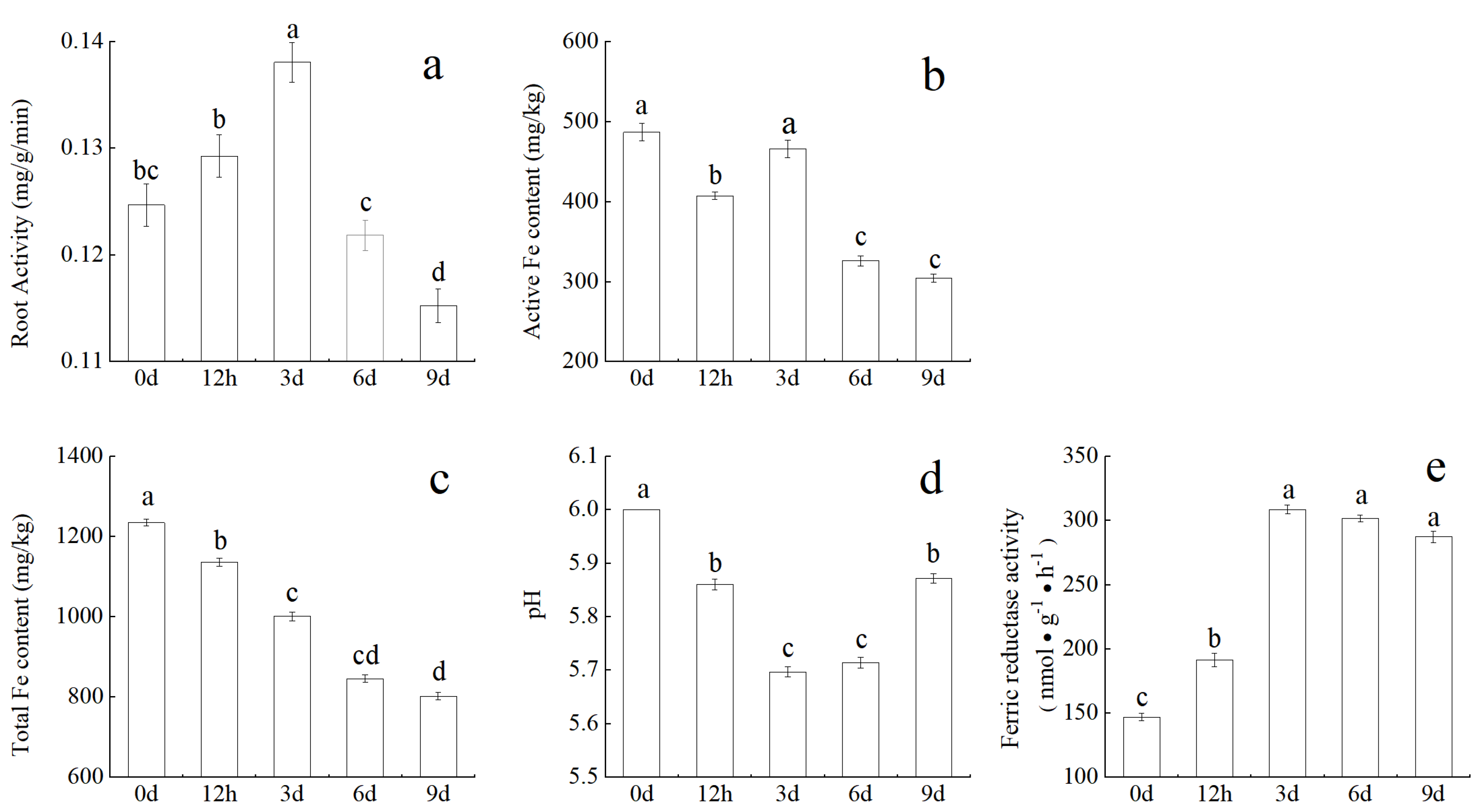
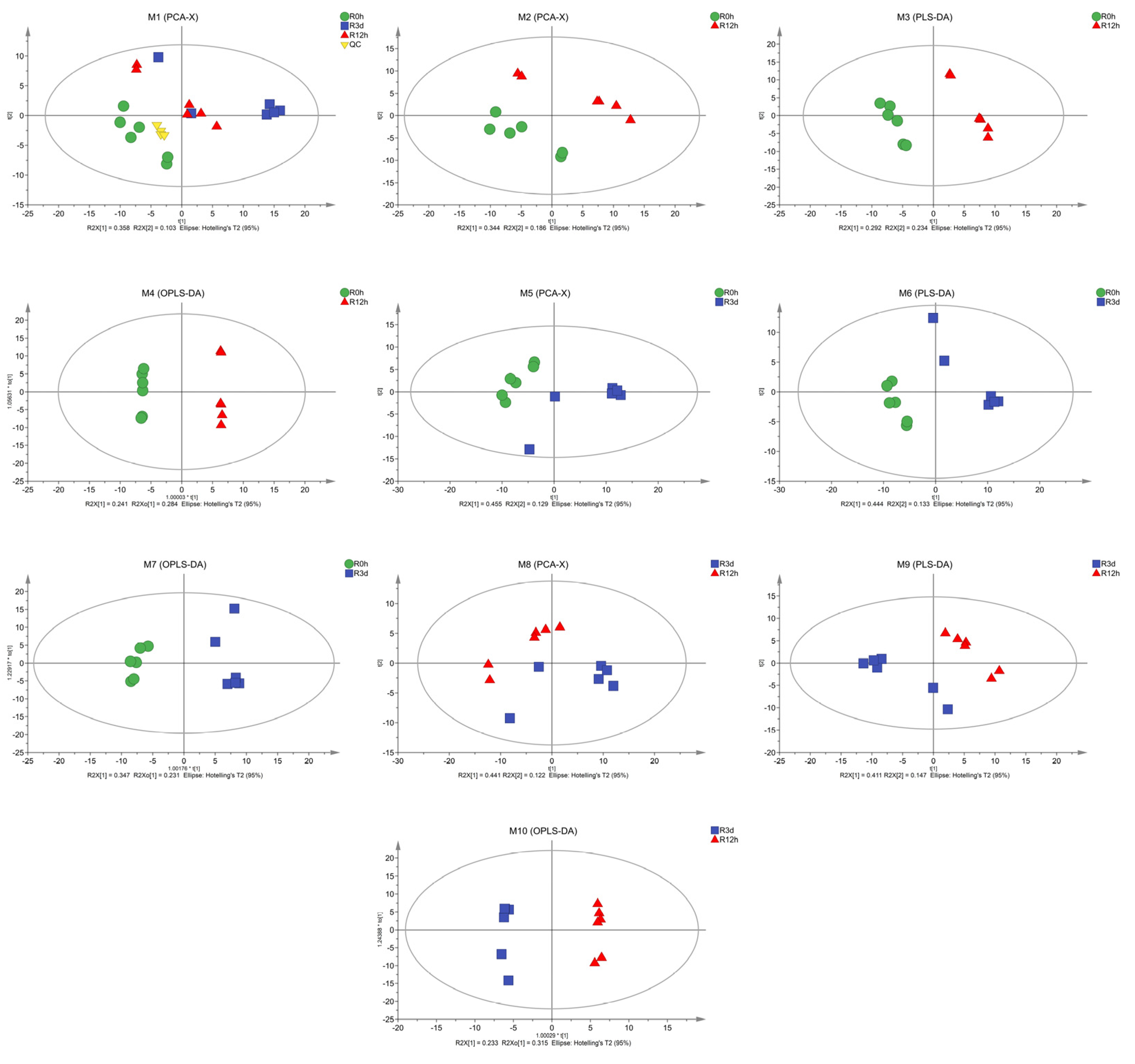
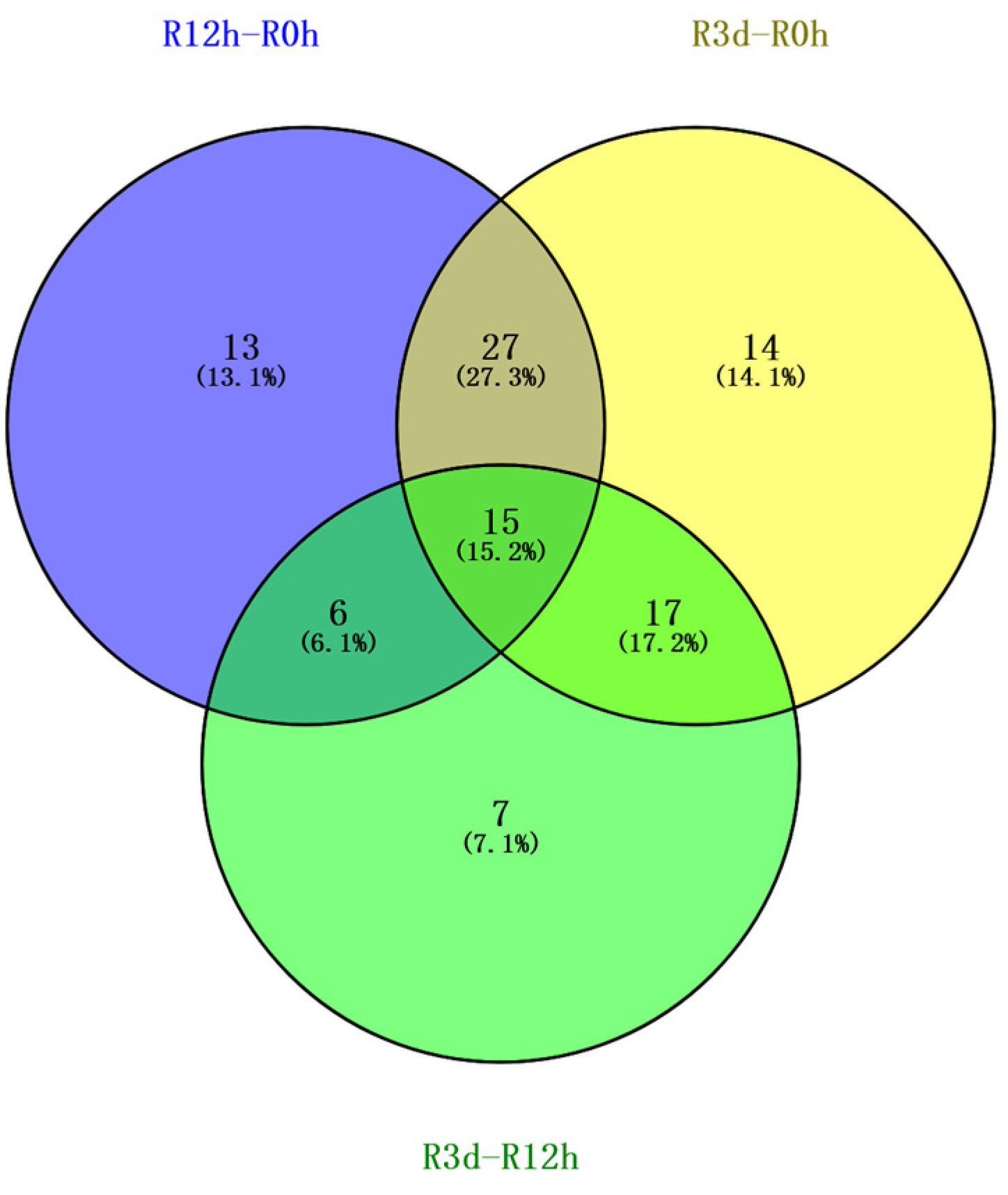
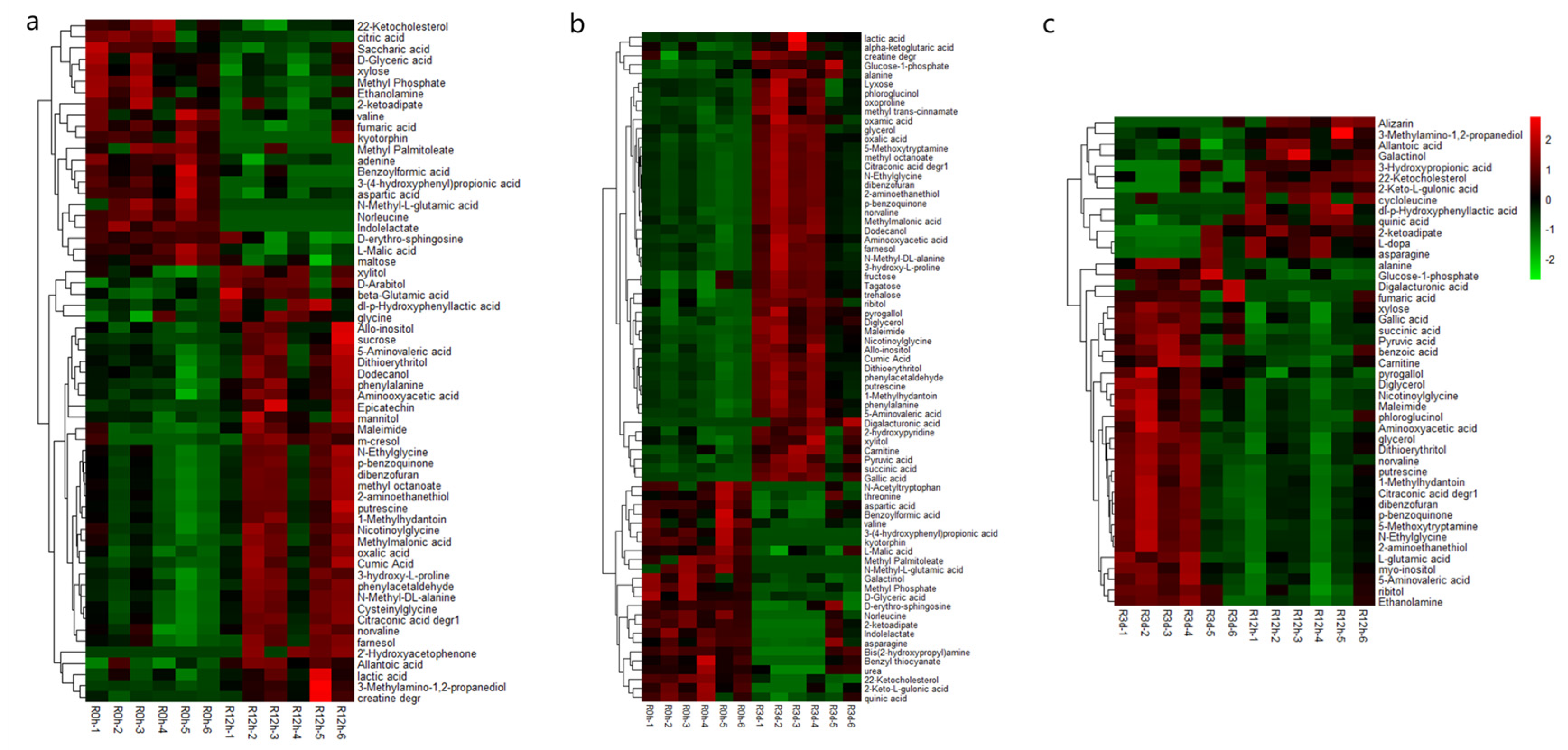

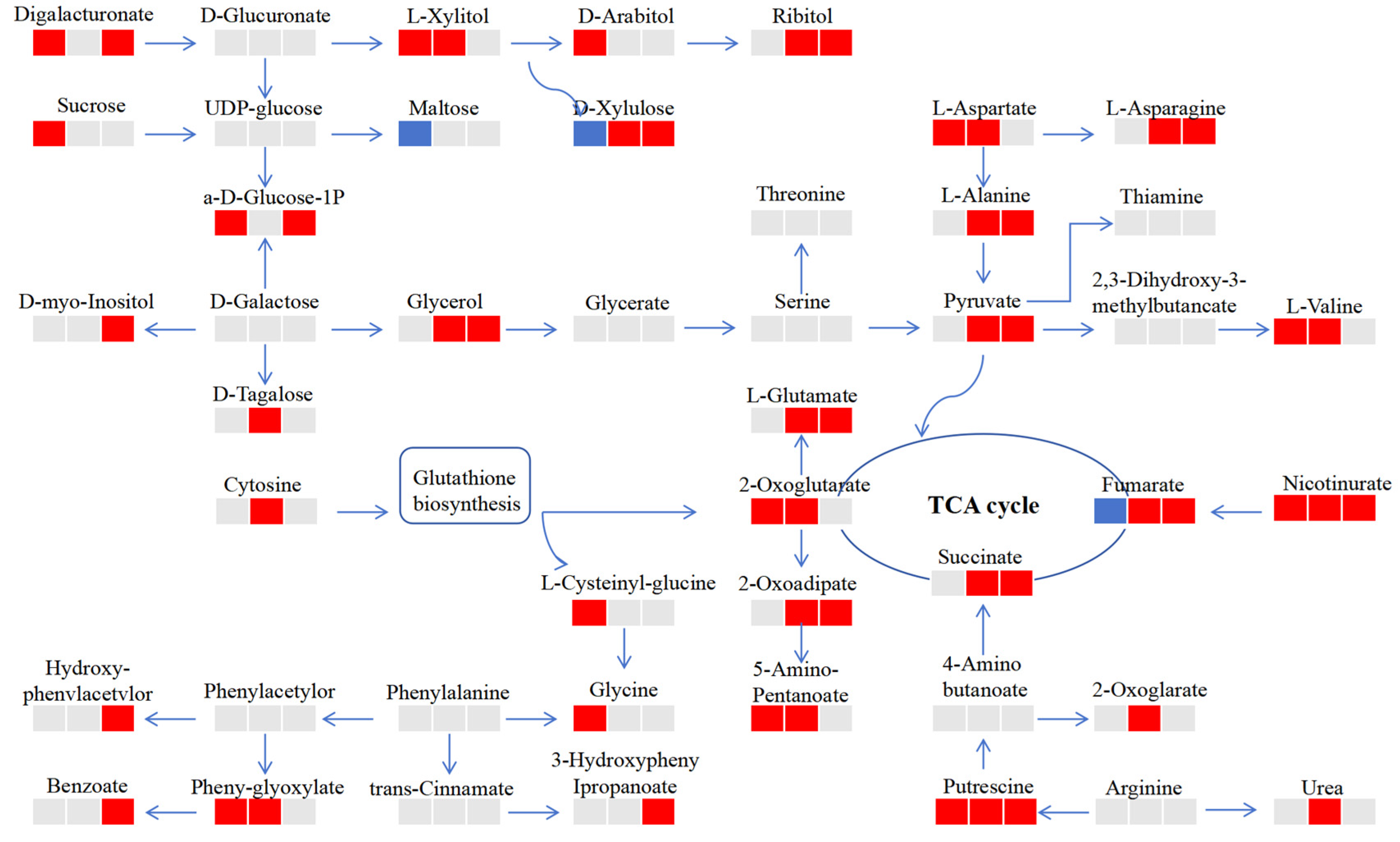
| Stress Time | Total Root Length/cm | Root Surface Area/cm2 | Average Root Diameter/cm | Total Root Volume/cm3 | Number of Root Tip | Number of Root Branch |
|---|---|---|---|---|---|---|
| 0 d | 290.989 ± 8.247 e | 14.642 ± 0.294 d | 0.430 ± 0.011 a | 1.303 ± 0.072 d | 1437.667 ± 43.190 e | 5819.333 ± 142.956 e |
| 12 h | 308.159 ± 8.828 d | 15.819 ± 0.034 c | 0.436 ± 0.011 a | 1.310 ± 0.023 d | 1689.333 ± 19.425 d | 6618.000 ± 210.231 d |
| 3 d | 343.605 ± 6.701 c | 16.296 ± 0.285 c | 0.439 ± 0.008 a | 1.764 ± 0.067 c | 2181.333 ± 86.153 c | 7302.333 ± 63.311 c |
| 6 d | 360.632 ± 4.774 b | 17.371 ± 0.095 b | 0.435 ± 0.006 a | 1.900 ± 0.044 b | 2659.000 ± 70.150 b | 7768.667 ± 153.468 b |
| 9 d | 383.538 ± 5.556 a | 18.630 ± 0.517 a | 0.449 ± 0.017 a | 2.210 ± 0.036 a | 3380.667 ± 25.423 a | 8453.333 ± 326.944 a |
Disclaimer/Publisher’s Note: The statements, opinions and data contained in all publications are solely those of the individual author(s) and contributor(s) and not of MDPI and/or the editor(s). MDPI and/or the editor(s) disclaim responsibility for any injury to people or property resulting from any ideas, methods, instructions or products referred to in the content. |
© 2024 by the authors. Licensee MDPI, Basel, Switzerland. This article is an open access article distributed under the terms and conditions of the Creative Commons Attribution (CC BY) license (https://creativecommons.org/licenses/by/4.0/).
Share and Cite
Chen, Y.-t.; Zhang, X.-y.; Zhang, D.; Zhang, Z.-x.; Wang, Y.-x. Metabolism of Malus halliana Roots Provides Insights into Iron Deficiency Tolerance Mechanisms. Plants 2024, 13, 2500. https://doi.org/10.3390/plants13172500
Chen Y-t, Zhang X-y, Zhang D, Zhang Z-x, Wang Y-x. Metabolism of Malus halliana Roots Provides Insights into Iron Deficiency Tolerance Mechanisms. Plants. 2024; 13(17):2500. https://doi.org/10.3390/plants13172500
Chicago/Turabian StyleChen, You-ting, Xia-yi Zhang, De Zhang, Zhong-xing Zhang, and Yan-xiu Wang. 2024. "Metabolism of Malus halliana Roots Provides Insights into Iron Deficiency Tolerance Mechanisms" Plants 13, no. 17: 2500. https://doi.org/10.3390/plants13172500
APA StyleChen, Y.-t., Zhang, X.-y., Zhang, D., Zhang, Z.-x., & Wang, Y.-x. (2024). Metabolism of Malus halliana Roots Provides Insights into Iron Deficiency Tolerance Mechanisms. Plants, 13(17), 2500. https://doi.org/10.3390/plants13172500





